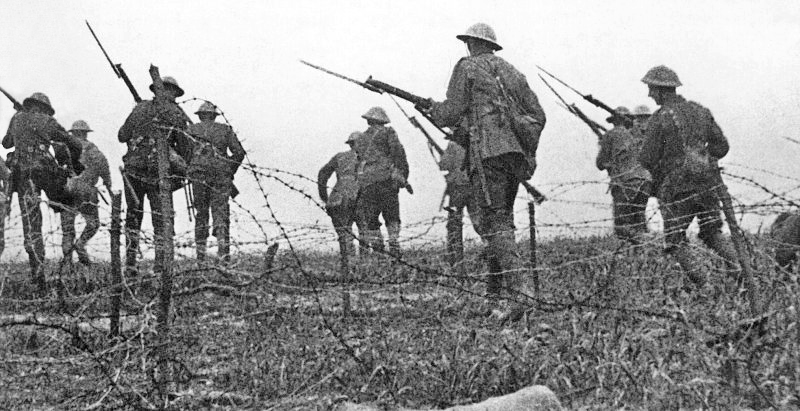Early combat models
Just over a hundred years ago now, US Navy lieutenant (later rear admiral) J.V. Chase developed a differential equation to model engagements between two homogeneous fleets. About a decade later, British engineer Frederick W. Lanchester arrived independently to an almost identical equation, with examples covering air and land combat as well. A Russian contemporary to both, M. Osipov, also reached similar conclusions in a paper published in the tsarist journal “Military Digest” (Voennyi Sbornik) in 1915.
Of the three, history has been kinder to Lanchester: Chase’s work was not declassified until 1972, too late for him to enjoy the public recognition he rightly deserved; and Osipov, although sometimes mentioned alongside his British counterpart, is still a relative stranger to us.
In practical applications, the simple combat models described by Lanchester and his contemporaries are mostly surpassed today – partly because of the more complex and dynamic nature of the modern battlefield, but mostly due to the power of calculation brought by the computer age, which makes much more sophisticated simulations possible.
And yet, Lanchester’s Laws, as we know them today, never quite seem to lose relevance. Many combat models introduced in the last few decades are directly evolved from them (COMAN, Bonder-Farrell), or use them at the local level to describe smaller engagements within a broader framework.
Lanchester’s Linear Law
Lanchester began by postulating a simple yet reasonable condition of ancient combat (close formations of men using swords or spears) in what he called the “Linear Law”: a combatant armed with a melee weapon can only engage one target at a time, within arm’s reach. What this means is that the casualties that a force could sustain or cause at any given instant have a practical upper limit, proportional to the number of its combatants that are in direct physical contact with the enemy. At most, this upper limit would be the number of active units in the smaller force, but further limitations could be imposed by terrain, or formation frontage. We will now examine an example of the latter:
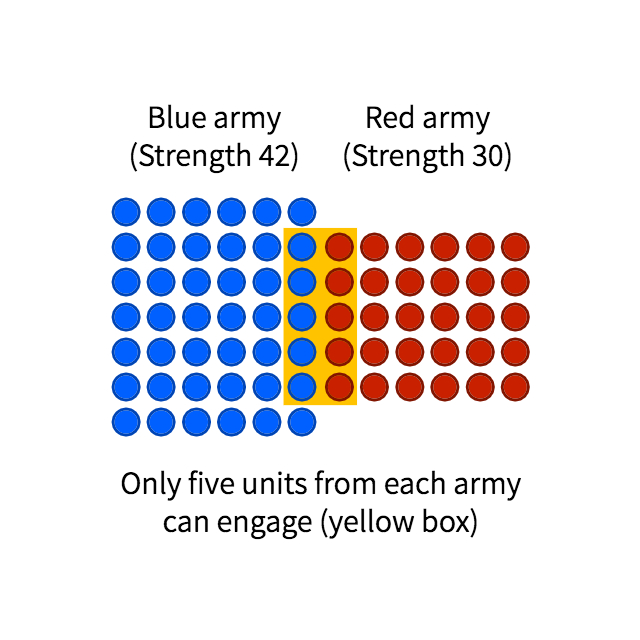
In the situation above, and given equal fighting skill for both sides, the Blue army and the Red army would cause the same exact number of casualties (five) per unit of time and would go on like that until the smaller army (in this case, Red) were wiped out.
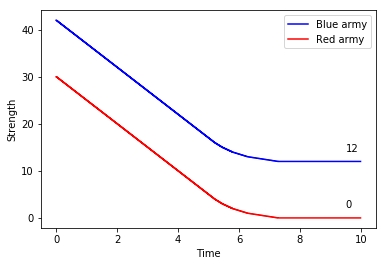
From the Blue army, 12 units survive the encounter.
Now, let us imagine the Red army is technically superior to the Blue army: due to a greater fighting skill, or better equipment, or a combination of both, any Red soldier can eliminate two enemies in the time it takes a Blue soldier to eliminate just one. In that case, the plot of the forces of both sides as a function of time would look like this:
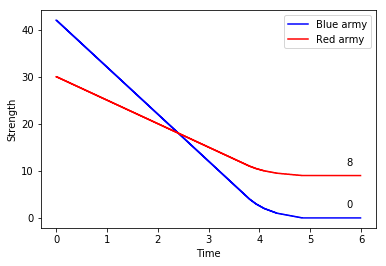
Red wins this time around, with eight survivors.
We can make the following observations from these two engagements:
- The attrition rate of both armies is constant throughout the battle (except by the end, when fewer soldiers remained than would fit the original frontage)
- A larger army does not confer a greater killing power – only a greater staying power, as the larger army can soak up more casualties before being eliminated.
- An army that is outnumbered two to one can compensate by being exactly twice as lethal. In other words, lethality and numbers have the same weight in deciding the outcome of a battle.
- Frontage does not really alter the outcome of the battle, only its duration.
According to Lanchester, exactly the same rules could be applied to a modern scenario of unaimed fire, in which both sides fired at an enemy they could not see, and merely swept a constant target area: in such a case, the larger side would have greater firepower, but this would be compensated by a lower density of enemy targets; the outnumbered side would have fewer guns, but their shots would find their mark more often. The result would be a constant attrition rate for both armies, exactly as in the melee combat examples above.
Lanchester’s Square Law
In modern combat using long range weapons and aimed fire, Lanchester continued, the restriction established by the Linear Law is lifted: now, any combatant can engage any target in range, and in turn receive fire from multiple enemies. Thus, attrition rate is no longer limited by frontage – every element can participate in every stage of the battle.
In these conditions, if an army had 20 fighting elements, and each were expected to eliminate one enemy unit on average every two “time steps” of a given encounter (whatever we actually mean by a “time step”, be it a minute or a day, depends on the scope of our simulation) then the army would be expected to eliminate 10 enemies on average per time step. In a general case, an army with a number of elements A, all of which participate in the encounter in one time step, will always cause a number of casualties to an army B of A times α, where α is the expected number of kills per element per unit of time on average. This translates into the following equations:
![]()
![]()
Where A and B are the number of soldiers in each army, and α and ß their average expected number of kills per soldier per unit of time. Today, we refer to α and ß as Lanchester attrition-rate coefficients.
Let us apply these equations to our prior example of a Blue army numbering 42 soldiers, and a Red army with a strength of 30. As before, we make both armies exactly as lethal – both will be expected, for this example, to neutralise one enemy every five time steps (1/5 = 0.2 kills per time step). Substituting these values in the previous equations, we obtain:
![]()
![]()
Which, plotted as a function of time, gives the following result:
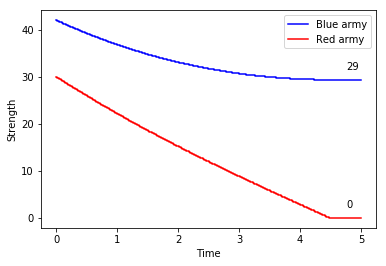
In our Linear Law example, with the same numbers, the Blue army won with only 12 surviving units. This time around, applying the Square Law, things are considerably more lopsided, as 29 elements of Blue survive unscathed.
Intuitively we can appreciate how, in the conditions established by Lanchester’s Square Law, superiority in numbers has a greater effect in the outcome of an encounter than the lethality of each individual unit – every casualty inflicted not only reduces the number of enemies that can fire back, but also increases the concentration of fire on each target in the next time pulse. A tacit agreement with Nathan Bedford Forrest’s military maxim “get there first with the most men”.
Analytically, we may divide the equations for the casualty rates, obtaining:
![]()
Which we can rewrite as:
![]()
to relate the instantaneous losses of both armies, and then integrate to find that:
![]()
Which shows that the fighting strength of an army is proportional to the square of its size – hence “Square Law”.
Validation of Lanchester’s Square Law:
As a combat model, Lanchester’s Square Law has some considerable limitations, among others:
- It assumes perfect intelligence, as both sides know the exact location of the enemy at all times.
- It assumes perfect fire control, as both sides can concentrate fire in the most efficient way.
- It assumes the conditions of the battlefield are constant, as the efficiency coefficients α and ß are unaffected by changes in terrain, manoeuvres, morale, supply, etc.
- It is a deterministic model, as the same input will always yield the same result.
- It is a homogeneous model, in that all elements of a combat unit are assumed to have the same fighting characteristics.
Many authors have proposed revisions and expansions of Lanchester’s work to correct some of these shortcomings, or to account for a variety of factors such as reinforcement and withdrawals, operational losses, command and control, guerrilla warfare and insurgency, the suppressive effects of weapons, close air support, etc. A detailed list of these developments up to the late 1970s can be found in James G. Taylor’s Lanchester-Type Models of Warfare, vol. I, 1980.
This said, we must look at the Square Law not as a combat model, but as an attrition model. In other words, we cannot expect it to paint a detailed view of the evolving battlefield, but rather to describe the mathematical process by which casualties are dealt and sustained, once all other factors are known.
And in that regard, it can do surprisingly well. Although other studies exist that illustrate the matter clearly, J.H. Engel’s 1954 paper on the battle of Iwo Jima shows a remarkable fit between theoretical vs. actual attrition rates using Lanchester’s Square Law:
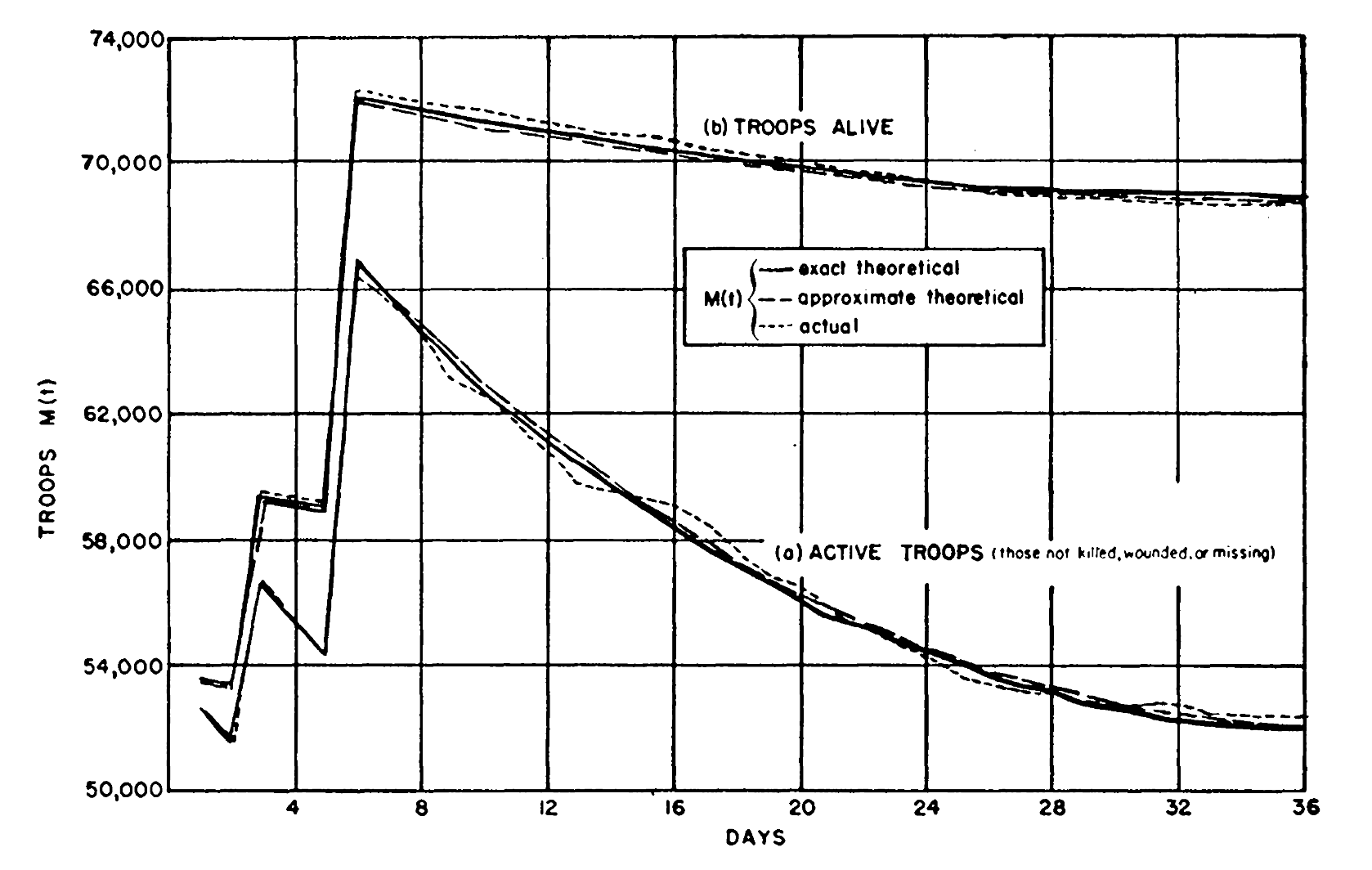
Conclusions
On the subject of Lanchester models of warfare, Professor James G. Taylor said in 1980:
We should, perhaps, be more amazed that such simple models yield intuitively appealing results than be critical because of the factors omitted from them. As is usually the case with simple analytical models, they may be too abstract to solve any specific real operational problem. They can, however, illustrate a general principle such as concentration, clearly delineate modelling issues, warn about potential difficulties, and serve as a basis for communication among analysts
Whether Lanchester models continue being practical is a different debate entirely, but one cannot deny that they continue being relevant, both in the field of Operational Research and outside it. The civilian study of military history, in particular, strikes us as a doctrine with no need to solve specific operational problems, but which could do with some insights into the dynamics of combat – a historian would not do far too wrong revisiting some past conflicts from an analytical perspective.
GitHub
The Python implementations of the models used in this article for plotting simulated combat results can be found in the author’s GitHub page.
